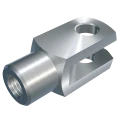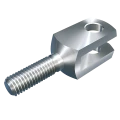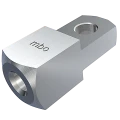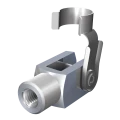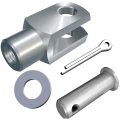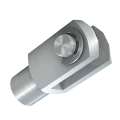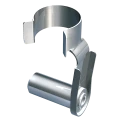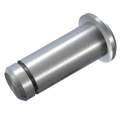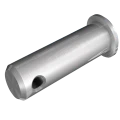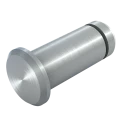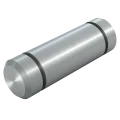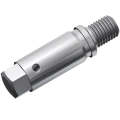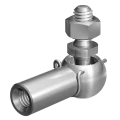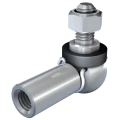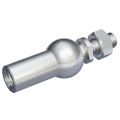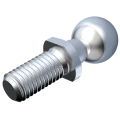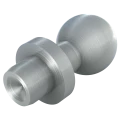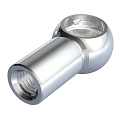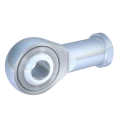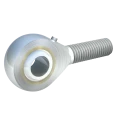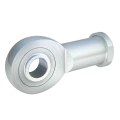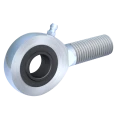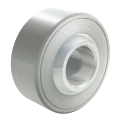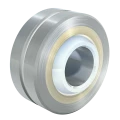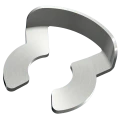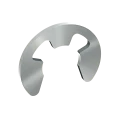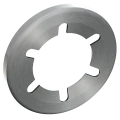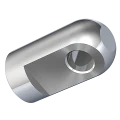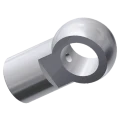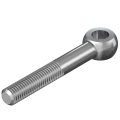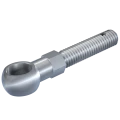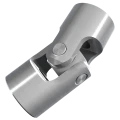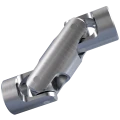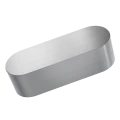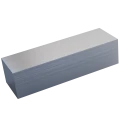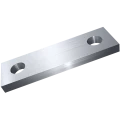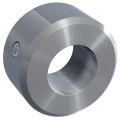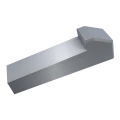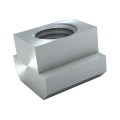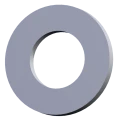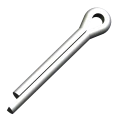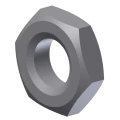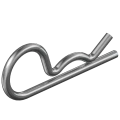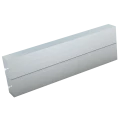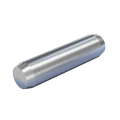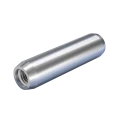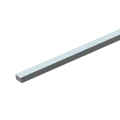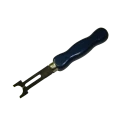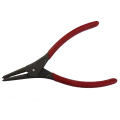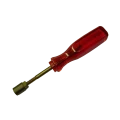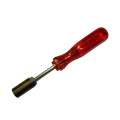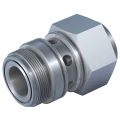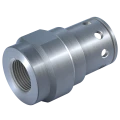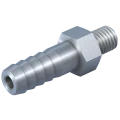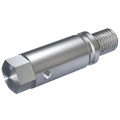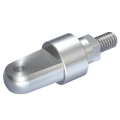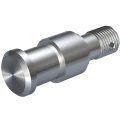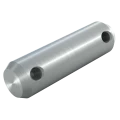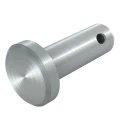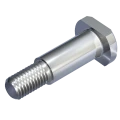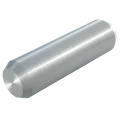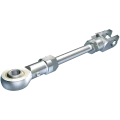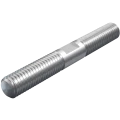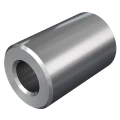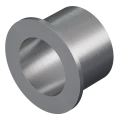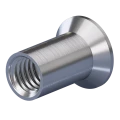To cancel your filter settings again, click on the "Clear" button below the table.
You can display product details, including the eShop function and 3D model , by clicking in the row corresponding to the required article.
1. Product description
Rivet studs DIN 71803 form B are high-precision mechanical linking elements designed for movable and flexible connections in industrial applications. They consist of a cylindrical shaft with which the stud can be riveted to other connection parts. At the end, the rivet stud concludes with a spherical head. This specific design allows for optimal force transmission while also providing a certain degree of flexibility. This enables loads to be efficiently absorbed and distributed without compromising the mobility of the entire system.
Rivet studs DIN 71803 form B, when mounted with a ball socket DIN 71805, form an angle joint DIN 71802 form B or form BS.
2. Product details
Size: B 6 x 3,5 - B 19 x 18
Material group: Steel, stainless steel, stainless steel A4 quality
Surface: bright, electr. galvanised white
d1 Ball diameter: 6 - 19
d5 Shaft diameter: 4 - 14
l1 Shaft length: 3,5 - 18
3. Application Areas & Compatibility
Mechanical engineering: In mechanical engineering, rivet studs are essential components for the connection and movement of machine parts. They enable precise movements and can withstand loads without losing functionality or reliability. In machine tools, conveyor systems, or packaging machines, for example, they ensure the correct guidance of moving parts, which is crucial for the function and efficiency of the machine.
Robotics: In robotics, rivet studs are used in robot arms and gripping mechanisms. Their use enables precise and flexible movements that are necessary for the exact execution of workflows. In industrial automation, they ensure that complex movements can be carried out without losing stability. This is particularly important in the manufacturing and assembly industry, where high precision and repeatability are required.
Automotive engineering: In the automotive industry, rivet studs are used in various areas, including trunk lids or hoods and other moving parts. Their ability to ensure stable and flexible connections directly contributes to the safety and longevity of vehicles. This is crucial for safe and efficient driving, especially under high loads and changing driving conditions.
Rehabilitation technology: In rehabilitation technology, rivet studs play an important role in devices that require precise and smooth movements. Examples include patient positioning systems and orthopedic devices. In patient positioning systems, they allow for safe and comfortable positioning of the patient, while in orthopedic devices they ensure precise movement corrections and support. The high precision and reliability of rivet studs contribute to the safe and effective operation of medical devices.
Compatibility
Rivet studs according to DIN 71803 are standardized components that ensure high compatibility with other elements manufactured according to the same standards. They fit with ball sockets according to DIN 71805 and can be used in various applications and systems that are also designed according to these standards. This greatly facilitates the exchange and integration into existing systems, ensuring consistent quality and reliability of the linking elements. In combination with a ball socket according to DIN 71805, rivet studs according to DIN 71803 form an angle joint according to DIN 71802.
4. Advantages and Benefits
Precise movements: The design of the spherical head of the rivet studs allows for precise and flexible movements across multiple degrees of freedom. This is crucial in applications requiring high precision and repeatability, such as robotics and medical technology. The precise mobility enables machines and devices to perform complex tasks efficiently and reliably.
Durability: The rivet studs are robustly constructed, providing high load capacity and long service life. They are made of high-quality materials such as steel and stainless steel, known for their ability to absorb large forces and withstand high mechanical loads. Additionally, the ball is hardened. These characteristics are particularly important in applications where components are regularly exposed to high stresses and vibrations, such as in automotive and mechanical engineering. The durable construction of the rivet studs helps to extend maintenance intervals and reduce operating costs, as they need to be replaced less frequently.
Corrosion resistance: Using materials like stainless steel and stainless steel A4 quality, or steel with various surface treatments such as galvanization, rivet studs provide effective protection against corrosion. This allows their use in aggressive environments, such as in the chemical industry or maritime applications. The corrosion resistance ensures a long service life and reduces maintenance requirements, leading to lower operating costs.
Diverse connection options: Rivet studs allow for easy integration into existing systems and offer solutions for different technical requirements. The diverse connection options facilitate the exchange and adaptation of components, enhancing the efficiency and adaptability of industrial processes.
5. Assembly and Installation
The correct assembly and installation of rivet studs DIN 71803 form B is crucial for the optimal performance and durability of the linking elements. Here the individual steps and important notes are explained:
Preparation
Before starting the assembly, all involved components, including the rivet stud and the ball sockets, should be thoroughly cleaned. Any impurities, such as dirt, dust or foreign particles, must be removed to ensure smooth and precise assembly. Clean contact surfaces also prevent effects on the accuracy of the movement and minimize the risk of wear and corrosion.
Lubrication
To reduce friction and minimize wear, thorough lubrication is essential. Lubricating grease is applied to the socket of the ball socket. High-quality greases or oils should be used that correspond to the specific application conditions. In high-load applications or environments with extreme temperatures, the use of special lubricants may be necessary to ensure permanent lubrication and protection against corrosion. The lubrication should be checked regularly and renewed if necessary to ensure optimal functionality and longevity of the connection.
Assembly
The rivet stud is carefully inserted into the corresponding ball socket. The circlip located in the socket slides over the ball of the ball stud and secures the stud in the socket. It should be ensured that the stud fits exactly into the ball socket and that no excessive force needs to be applied. Proper insertion ensures a perfect fit and contributes to the functionality of the entire assembly. It is important that the stud remains freely movable and that no tensions or jamming occur.
By following these steps and notes during the assembly and installation of rivet studs, it is ensured that the linking elements perform optimally and achieve a long service life. Careful and professional assembly helps to ensure the efficiency and reliability of mechanical systems in various applications.
6. Safety instructions & Standards
The proper handling, installation, and maintenance of rivet studs DIN 71803 form B require special attention to ensure safe and reliable operation. Here are the key safety instructions and standards in detail:
Safety inspections: Regular visual inspections, as well as mechanical and functional tests of the rivet studs, are essential to detect wear and damages early. These inspections should be carried out at set intervals and before each operation. Particular attention should be paid to cracks, deformations, or excessive wear. Mechanical tests can be supplemented with load tests, where the rivet studs are tested under real operating conditions to ensure their functionality and load capacity. Such measures enhance safety and help prevent unforeseen failures.
Load limits: Adhering to allowable load limits is crucial to prevent damage and failures. Overloading the rivet studs can lead to material fatigue, deformation, or breakage, which not only affects functionality but also poses a significant safety risk.
Standards: The manufacturing and quality of the rivet studs are strictly aligned with DIN 71803. This standard ensures that the rivet studs offer high compatibility, consistent high quality, and compliance with technical requirements. Compliance with the DIN standard means that the products have standardized dimensions, material properties, and load values, facilitating their interchangeability and integration into various systems. Using products manufactured to DIN standards ensures that you receive components of high quality and reliability.

